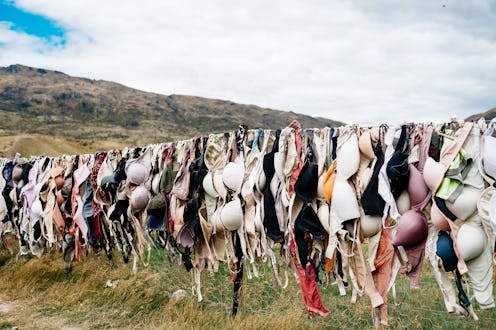Life
A More Comfortable Mammogram Is On Its Way, & It’s A Breast Health Game Changer
Mammograms are kind of an inevitability for people with breasts. They're considered the best method, in addition to breast self-exams, to detect symptoms of breast cancer for women over 50 or younger women who are at risk, though the guidelines on how often mammograms are needed are changing. One definite problem with mammograms, though, is that they can be really painful. The procedure involves placing your breasts between two flat plates, applying pressure, and scanning the breast tissue. Round breast + flat panel = who thought of this? But a new innovation involving curved mammogram plates may be beginning to make the procedure actually breast-friendly — finally.
Mammogram pain is particularly an issue if you have very small or fibrocystic breasts. (My mother, who has A cups, reported extreme difficulty getting the tissue into a position that provided a clear scan, and the technician's puzzlement about how to do it without hurting her.) Keeping breasts in place for mammograms can cause bruising, though the compression isn't dangerous for any other reason. The innovation proposed by the company behind the new mammogram plates, Hologic, seems pretty intuitive, but it marks one of the first developments in mammogram technology in quite a while, and, it's hoped, might save more lives by encouraging women not to avoid their doctor's office like the plague.
What A Curved Mammogram Means
Mammogram technology emerged in 1913 when Albert Salomon, a German scientist who would later survive a concentration camp in World War II, revealed he'd used radiography to scan breast tumors. In the 1950s, mammograms were performed by attaching long cones to X-ray machines and compressing the breast underneath, which is just as pleasant as it sounds. Today's mammogram machines are more sophisticated, but they operate under the same basic principle: compressing the breast between flat plates to get a good image of tissue inside. Unfortunately, that hurts.
The plate developed by Hologic aims to reduce discomfort by mimicking the natural curve of breast tissue. "Breast pain experienced during a mammogram is directly related to the time spent under compression and the pressure distribution on the breast, two factors that must be addressed to improve the mammography experience," the company said in a press release. Their plate, which is called the SmartCurve, is meant to spread the force of the compression over breasts more comfortably. In a survey, they found that 93 percent of women who had had uncomfortable mammograms preferred the Smartcurve to traditional flat methods. Those numbers need to be tested out in the wild, but most importantly, Hologic believes their system doesn't compromise on the mammogram's quality or on how tricky it is to administer. So is this the new age of the breast exam?
Why Reducing Mammogram Pain Is So Important
The Smartcurve system is being touted as a way to get more women to have mammograms; Fast Company, in an article about Hologic, noted a study that found that discomfort is the biggest reason women avoid mammograms. There have already been attempts to make mammography less painful; a device debuted in 2015 that measured the pressure exerted on breasts between mammography plates, to try and help patients control how much pain they'd be in. But this is the biggest change in a long time to the structural composition of mammography itself. And it seems important to ask: Why on earth did this take so long?
Pain has been part of the mammography package for a long time. One essay on XOJane noted that her technician "confused the mammography machine with an industrial panini press." Rather like many other aspects of female-focused health that are either uncomfortable or really painful — using stirrups for gynecological examinations, having speculums placed up your nethers, the charming scrape of the Pap smear — women's comfort during a routine medical procedure hasn't exactly been a priority. Which, you may argue, is the correct order of things: if it's accurate and medically helpful, women should be able to endure a little pain. But if it's possible to have excellent medical outcomes without unnecessary pain for female patients, as this innovation suggests, it seems more valuable to investigate more comfortable methods than to keep telling women to grin and bear it.
More comfortable mammograms are a big deal. As Julia Louis-Dreyfus noted in her now-viral post revealing her breast cancer diagnosis, one in eight American women will experience breast cancer in their lifetime. If you're in the age group for whom mammograms are recommended (according to the Centers for Disease Control, you can start getting them as young as 40, but speak with your doctor if you are high-risk or experiencing symptoms), then the Smartcurve innovation, and hopefully similar products that come afterwards, will remove any excuses not to get checked. No more bruised breasts for the sake of health.
